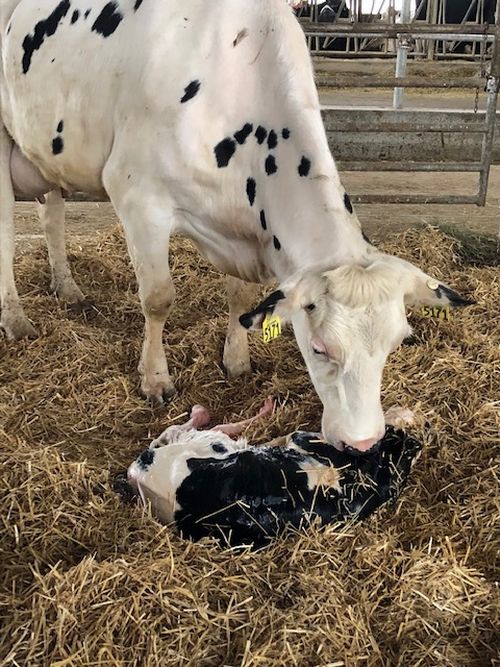
Even though the immune system of a newborn animal is functional at birth, it is less responsive than that of an adult cow and is naive and easily overwhelmed by the bacteria, viruses, or parasites in the environment. Prolonged exposure or an increased level of exposure occurs when susceptible dairy newborn animals remain in the calving area, have continued contact with adult cattle, are in contact with affected newborn animals, commingle with sick cows, or are housed in facilities that are under-bedded, warm, damp, humid, or poorly ventilated. Noxious gases, specks of dust, and mould in the air put newborn animals at significant risk for developing pneumonia. Cold housing can reduce the risk of infection, provided newborn animals can be dry and draft-free. New-born animal-to-new-born animal contact, crowding, or continuous use of facilities prolongs the survival rate and increases the numbers of pathogens in the environment of the newborn animal, even with cold housing.
Inadequate colostrum intake or absorption puts newborn animals at significant risk of infection from septicemia, enteritis (diarrhoea), or pneumonia. Dairy newborn animals should be hand-fed 3 litres (Jerseys, Guernseys, Ayrshires) or 4 litres (Holsteins, Brown Swiss) of colostrum. The entire volume should be from the first milking of a single cow. Colostrum can be delivered in one or two feedings prior to the newborn animal reaching 12 hours of age. The entire volume can be delivered safely and effectively in a single feeding. New-born animals can suckle, be fed by an oesophageal feeder, or receive colostrum by a combination of the two methods.
Colostrum should be collected from appropriately prepared cows within 6 hours of freshening. Collection and storage containers should be sanitized between sequential uses. For effective cooling, colostrum should be placed in 2- or 4-litre containers that can be clearly labelled with cow identification and date of collection. Fresh or refrigerated colostrum provides the best combination of antibodies (immunoglobulins), immune cells, other important immune factors (lactoferrin, lysozyme, and complement), vitamins, and minerals important to the immune system of the new-born animal. The availability of frozen colostrum allows the producer to discard colostrum from cows with mastitis, bloody milk, diarrhoea, or Johnes disease and supplement the colostrum from a first-new-born animal heifer, purchased animals, or incompletely transitioned cows. Refrigerated colostrum should be used within 1 week and frozen colostrum within 1 year of collection.
The use of mastitic- or antibiotic-containing waste milk has been related to high mortality rates. Many producers feed milk replacers to decrease the potential transmission of infectious diseases. Colostrum absorption may be compromised in newborn animals born in extreme heat or cold, newborn animals that have difficult deliveries or abnormal gestational length, or those exhibiting respiratory difficulty. Other non-colostral factors that impair the immunity of newborn animals are inadequate caloric intake; crude protein deficiency; selenium deficiency; low levels of vitamins A, C, or E; reduced stores of copper, manganese, and zinc, or iron; and coccidiosis. Inadequate caloric intake puts newborn animals at risk for disease.
For dairy newborn animals, inappropriate volume, concentration, fat or protein content, mixing, or feeding temperature of milk or milk replacer can compromise the immunity of the newborn animal. Failure to provide fresh water and a palatable newborn animal starter that is supplemented with a coccidiostat and presented in a clean feeder will enhance their susceptibility to disease. Consistent feeding practices (timing, presentation, temperature, and quality of feeds) and personnel and management practices enhance the non-specific immunity of the newborn animal.
Make sure that there are adequate feeding utensils to be able to clean and disinfect between uses on sick newborn animals. A dedicated utensil for sick newborn animal use is ideal. This means that there are enough oesophageal feeders to dedicate one to each sick newborn animal for that feeding or that day. Contain risk by reducing newborn animal stress. Stress is imposed when newborn animals are asked to adapt to change. Feed changes - colostrum to whole milk to milk replacer, dilute milk replacer to concentrated milk replacer, milk withdrawal and reintroduction - create stress. Each time there is a housing change - maternity pen, warming area, newborn animal hutch, group pen, or transport to a different location - the newborn animal is more susceptible to disease. Depending on timing, amount, and type, vaccinations or medications can impose significant health risks on young newborn animals. Keep things simple for newborn animals.
Feed a single, large volume feeding of colostrum. At the second feeding, begin feeding the milk replacer or milk that will be the mainstay of the newborn animal’s pre-weaning diet. Feed the liquid feed at a consistent time, temperature, and concentration throughout the pre-weaning period. Adjust in volume or number of feedings for cold temperatures or illness. Provide newborn animal starters within the first week of life.
Move the dairy newborn animal from its calving area and place it in its permanent pre-weaning home as soon as possible after birth. Avoid crowding and competition, particularly before, during, and immediately after weaning. Under most circumstances, dairy replacement heifers that receive adequate colostrum from vaccinated dams have little or no need to be vaccinated before weaning.